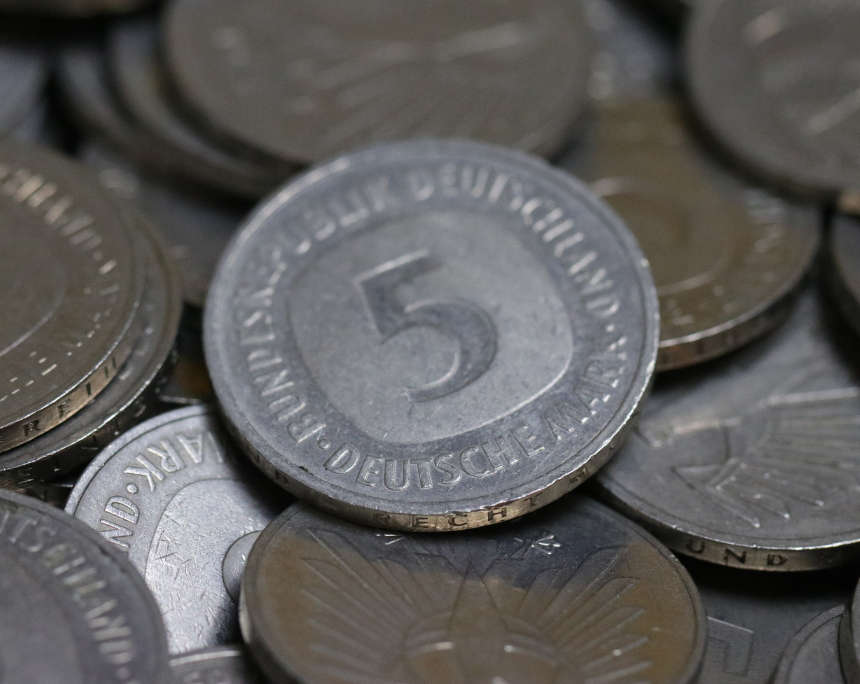Marks and Pfennigs in Your Inheritance: What Should Heirs Do with Old DM Coins?
By Sebastian Wieschowski
After an inheritance, heirs are often confronted with individual coins and banknotes or entire coin collections from the Deutsche Mark era. After World War II, many Germans discovered coin collecting as a hobby, regularly securing the latest commemorative coins from their bank or keeping an eye out for rare dates in their change. These coins were carefully stored for decades and now represent a connection to a bygone era. But the question remains: what are these old coins actually worth?
Content
The reality is sobering for most heirs. Despite the emotional value that such collections may hold, the majority of coins from the Deutsche Mark era have little to no collector’s value. There are many reasons for this: often, they are mass-produced items, minted in large quantities, or commemorative coins that, while testifying to historical events, are not particularly sought after due to their non-precious metal composition. Thus, heirs are faced with the question of what to do with these coins.
Small Change in Pfennigs and Marks: The Bundesbank as the Final Destination
Unlike in most other Eurozone countries, Germans have a significant advantage when it comes to coins from before the Euro was introduced: the Bundesbank exchanges DM coins and banknotes into Euros without any time limit. As a result, most small coins from the Deutsche Mark era, whether neatly sorted in coin albums or stored in tins, ultimately end up being melted down and recycled rather than being passed on as collections.
However, it’s worth taking a closer look: certain pieces could have a market value due to special mintings or specific years. Therefore, before heading to the Bundesbank, it is advisable to get a professional assessment to avoid sending potentially valuable coins unnoticed to the melting pot.
Little Treasures in Grandpa’s Change
Before exchanging circulation coins from the Deutsche Mark era, it’s advisable to search through the coin collection for small and large rarities. It’s quite likely that heirs will come across the following commonly found Mark coins:
- The 1 DM coin from 1954 with the mintmark “G” is traded for 5 to 10 Euros due to its relatively low survival rate.
- The 2 DM circulation coins from 1951 had a short lifespan; due to the risk of confusion with the 1 DM coins, they were withdrawn from circulation after only a few years and are no longer exchanged by the Bundesbank today. This is good news, as their market value, depending on their condition, is between 10 and 20 Euros per piece – despite the mintage running into the tens of millions.
- All 5 DM circulation coins from 1951 to 1974, like the commemorative coins of that era, contain a silver content of 625/1000. The “Silver Eagles” are thus valued by precious metal dealers at the same rate as the 5 DM commemorative coins minted up to 1979.
Top Rarities: The Dream of Every Coin Collector
Even though the chances are slim that one of the legendary rarities from the numismatic era of the Deutsche Mark will be found in an inheritance, heirs and collectors should pay special attention to the following treasures:
- 2 Pfennig Coin (1969 J): A needle in a haystack is a specimen that was minted in pure copper. Only around 500 pieces are said to exist, while the standard version in iron was produced approximately 40 million times. A simple test provides certainty: if the magnet repels the coin, it is the rare copper version. The market value in the coin trade: between 1,000 and 2,000 Euros.
- 5 Mark Coin (1958 J): With a mintage of only 60,000 pieces, this Silver Eagle is a rarity and, with a bit of luck, might be hidden in a collection of silver coins. The market value in typical circulated condition is around 300 Euros, with better-preserved pieces being extremely rare.
- 50 Pfennig Coin (1950 G with the inscription “Bank Deutscher Länder”): This inscription was supposed to be discontinued after 1949, and German coins were to be inscribed with “Bundesrepublik Deutschland” instead. However, about 30,000 pieces still bear the old designation. Market value in circulated condition: 100 to 200 Euros.
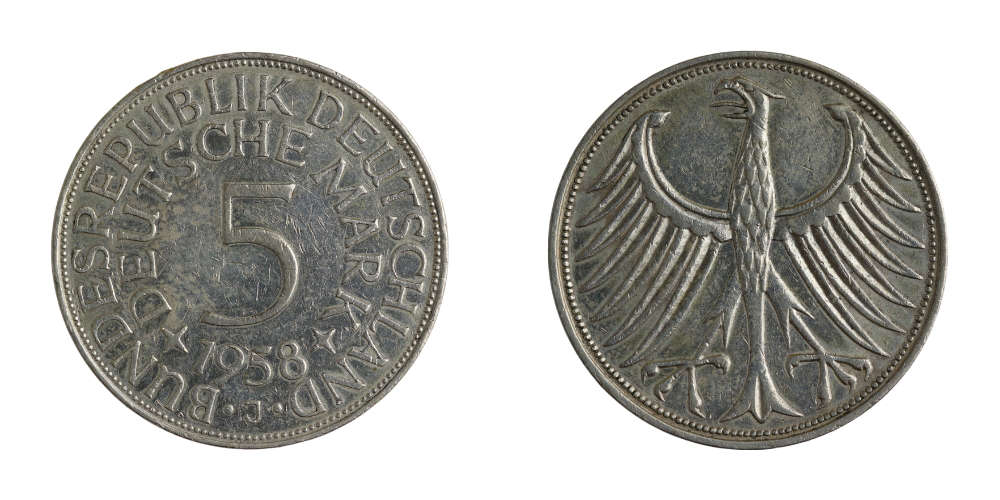
A rare find in the silver treasure: The 5 Mark coin from 1958 with the mintmark “J” has a market value in the three-digit range even with significant signs of wear. Photo: Wieschowski.
However, caution is advised: to this day, a real hype is maintained around these exceptional coins in online and print media, suggesting that such treasures can easily be found in any piggy bank. In reality, however, finding one of these numismatic rarities is like winning the lottery and is highly unlikely.
Commemorative 5 DM Coins from 1952 to 1964: The “First Five”
At a time when hardly anyone was thinking about coin collecting, numismatics was reborn in Germany: the famous 5 DM silver coin “Germanisches Museum” from 1952 became the symbol of post-war German coin collecting, followed by silver commemorative coins honouring Friedrich von Schiller (1955), the Margrave of Baden (1955), and Joseph Freiherr von Eichendorff (1957).
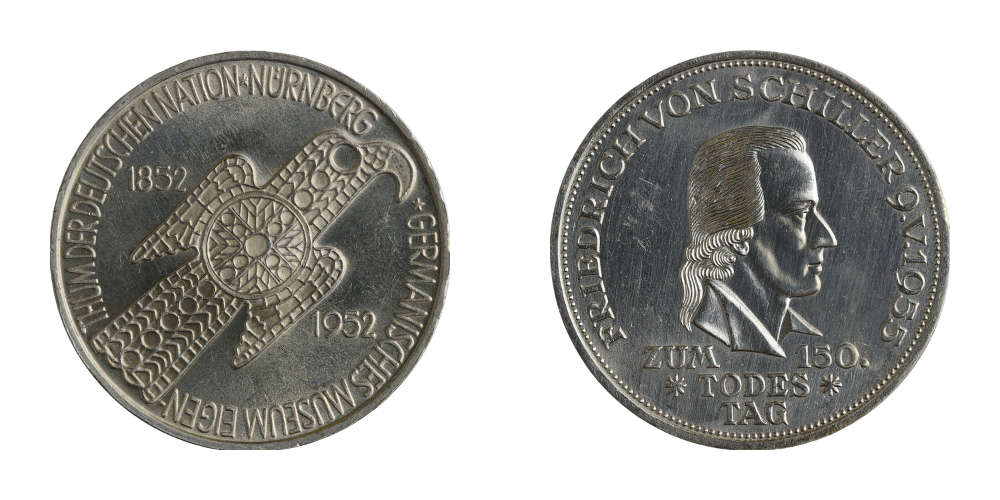
The rebirth of numismatics in Germany after the war: With the Germanisches Museum and Friedrich Schiller, Germans rediscovered coin collecting. Photo: Wieschowski.
Those who find these coins in an inheritance can consider themselves lucky – because the first issue from 1952 fetches around 250 to 300 Euros in resale, while the other commemorative coins from the 1950s bring in around 100 Euros each. This is mainly due to the low mintage of less than 200,000 pieces in mint condition.
With the increase in minting numbers in 1964 to a total of 500,000 pieces, including 5,000 in “Proof” condition, the collector’s value of these commemorative coins plummeted: the fifth commemorative coin, issued on the 150th anniversary of Johann Gottlieb Fichte’s death, has a resale value of around 20 Euros.
Even though the market value for German commemorative coins has been steadily declining for many years, there are still buyers for the so-called “First Five” – including collectors who couldn’t afford a “Germanisches Museum” in their childhood and are now fulfilling their numismatic dreams.
Commemorative 5 DM Coins from 1966 to 1979: A Legacy to “Cash In”
In 1966, the mintage of German commemorative coins exceeded the million mark for the first time – and was drastically increased shortly thereafter.
The result: the coins commemorating the 250th anniversary of Gottfried Wilhelm Leibniz’s death (1966) and the 200th birthdays of Wilhelm and Alexander von Humboldt (1967) are now traded at just above their silver value, with all subsequent coins up to 1979 being valued primarily based on their silver content.

The commemorative coins from 1966 and 1967 mark a transition – also in terms of collector value. For all subsequent years, the silver price determines the current market value. Photo: Wieschowski.
The coins have a gross weight of 11.2 grams and an alloy containing 625/1000 silver – resulting in a fine weight of 7 grams. To calculate the current silver value, divide the price of a troy ounce of silver by 4.44. For example, if the silver price is 30 Euros per troy ounce, a commemorative 5 DM coin would be worth around 6.75 Euros – more than double its face value, which is equivalent to 2.56 Euros.
However, heirs will need to visit a precious metal dealer who buys silver coins at their metal value; the Bundesbank does not calculate the precious metal content separately – although the friendly bank clerks often advise customers that they could get a higher return by selling their commemorative coins minted before 1979 elsewhere.
The end of silver coins was sealed in the late 1970s when the Hunt brothers’ silver speculation caused silver prices to skyrocket – at that time, the metal value exceeded the face value, and the 5 DM commemorative coins were switched from a 625/1000 silver alloy to a base metal mixture.
Commemorative 5 DM Coins from 1979 to 1986: Mass-Produced Magnimat
The special minting to commemorate the 100th birthday of Otto Hahn in September 1980 marked the beginning of a new era in the history of German commemorative coins – and from the perspective of many collectors, it was not a high point: instead of silver, an alloy was used that consisted of about 3/4 copper and 1/4 nickel with a pure nickel core (Magnimat).
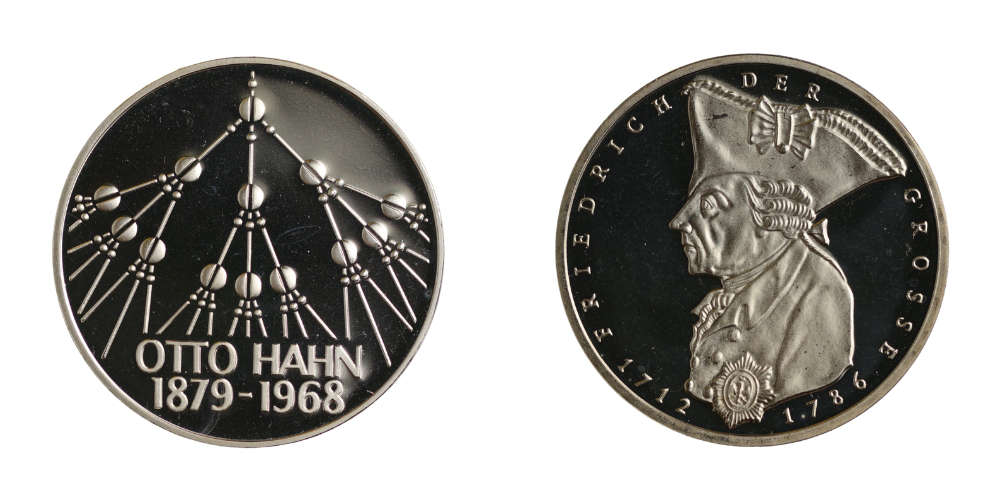
Not a high point in German numismatics: The switch from precious metal to a base alloy marked the end of the 5 DM coin series – here are the first and last issues from 1979 and 1986. Photo: Wieschowski.
The high minting numbers (5 million at the beginning of the 1980s, increased to 8 million pieces by the end of the 5 DM coin series) combined with the base metal ensure that all German commemorative 5 DM coins minted after 1979 are now considered mass-produced items and can be exchanged at the Bundesbank for their face value – at least yielding 2.56 Euros per coin.
Commemorative 10 DM Coins from 1972 to 1997 and from 1998 to 2001: A Numismatic Silver Lining on the Horizon
For many coin collectors, the passion for numismatics began in the early 1970s when 10 DM commemorative coins were issued to finance the 1972 Munich Olympic Games. After the games, the 10 DM denomination was revived in 1987 as the successor to the popular 5 DM coins. Up until 2001, there were a total of 43 different 10 DM commemorative coins. The year 1997 is significant for determining value – since at the end of that year, the silver content was adjusted:
- All silver 10 DM coins up to 1997 had a silver content of 625/1000 and therefore, with a gross weight of 15.5 grams, had a fine weight of 9.69 grams (or roughly 1/3 of a troy ounce). To determine the metal value, divide the current price of a troy ounce of silver by 3.2. For example, if the silver price is 30 Euros per troy ounce, the 10 DM coins minted up to 1997 would have an approximate market value of 9.35 Euros.
- From 1998 to 2001, sterling silver (925/1000) was used, increasing the fine weight to 14.34 grams (or slightly less than half a troy ounce). The rule of thumb for valuation: silver ounce divided by 2.2 equals the market value for 10 DM silver coins from the years 1998 to 2001. In our example, with a silver price of 30 Euros per troy ounce, heirs could expect around 13.80 Euros per coin.
The most Important takeaway for heirs: all silver 10 DM coins from the Federal Republic of Germany, whether minted before or after 1997, are worth significantly more than their face value of 5.11 Euros and should not be exchanged at the Bundesbank.
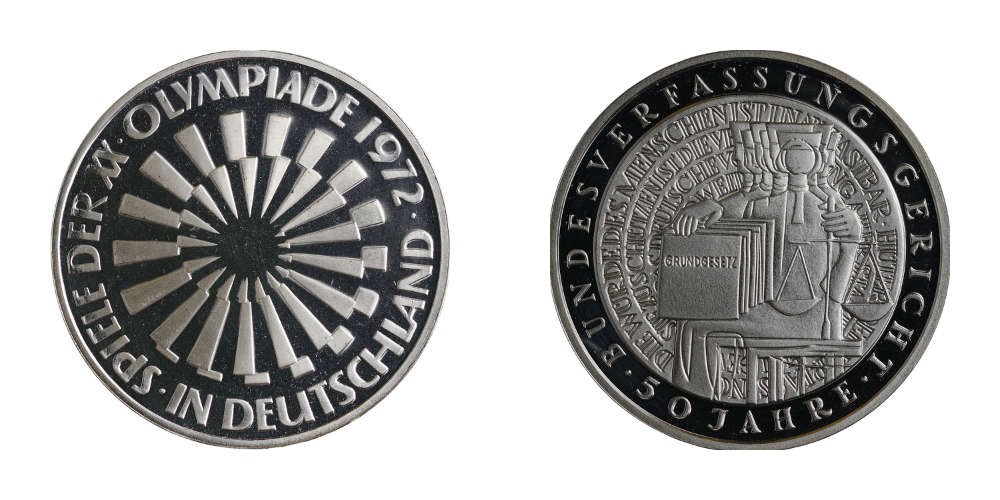
Olympic silver (1972) and the end of the Deutsche Mark commemorative coin era (2001) – all 10 DM coins are traded well above the exchange rate of 5.11 Euros. Photo: Wieschowski.
Conclusion: DM Coins as Inheritance – A Legacy Beyond the Exchange Rate
All valuations mentioned refer to coins in typical circulated condition, meaning with signs of use. If coins are in uncirculated condition, the market value could be significantly higher – in such cases, a coin catalogue can provide an initial orientation, and cross-referencing with auction house results or dealer price lists can offer final certainty.
Despite the objective assessment of coins from inheritances, it’s important to remember that these collections represent far more than just material value. They are the result of a loved one’s passion, who invested much effort, time, and often money into building their collection. These coins are a testament to their dedication and personal interest, nurtured over many years. Therefore, they deserve appreciation that goes beyond mere financial considerations.
Every heir should seriously consider whether they might want to continue the collection, regardless of the monetary value of the individual coins. Continuing the collection could be a meaningful way to keep the memory of the deceased alive while also building a personal connection to this unique hobby. Even if the coins do not have a high market value, they carry a history within them that is worth preserving and passing on.







